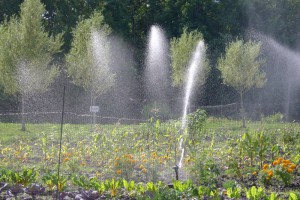
Plumes of water emerging from an irrigation sprinkler. Lärjedalen gardens, outside Gothenburg, Sweden.
Photo: Lasse Johansson
Swish, swish, swish, I have to run to escape the plumes of water cascading round and round over the small field. Innumerable water droplets journey together, upwards, upwards, then turning, falling, dissolving into a cloud of rain. Down below, the garden plants gratefully receive the life-giving water drops, capturing the droplets with their leaves. Some droplets continue, trickling down onto the bare umber soil underneath, wetting the soil and darkening it. Seeking its way into the hollows, seeping down, absorbed by the clayey, colloid substance that forms the fertile topsoil.
Some of the water takes another route, the heat from the sun, bathing the bare hot topsoil, causes the surface water to evaporate, drifting away with the wind. Slowly, slowly, the water cools the top surface, wetting it, causing it to be more willing to absorb the falling water.
In the temperate north, with its abundant supply of water, the drifting and evaporating water droplets matter little, and can easily be afforded for the benefit of the plants. But in a hotter climate, the ratio would be different, with more water evaporating, shifting the weight of the balance. There, excessive watering causes the groundwater level to sink, slowly and steadily. A NASA study in 2009 showed that the water table in northern India, a densely populated region with intensive agriculture, is sinking with one metre every three years. And when it rains, the soil may not be able to accept the water. On a dry and compact soil, most of the water will just run off the surface, rushing down onto lower lying land, creating floods.
I look again at the irrigation system, pondering: Cascading round and round, will the motion of water itself affect how it penetrates into the ground?
At least some tentative experiments have been done. Vortexing water, subjecting it to a powerful swirling motion in a tube before it is released through the nozzle into the air, seems to improve its absorption by compact soil. Some field trials with vortex water irrigation systems on golf greens on Malta have shown an improved water absorption, decreasing the water consumption with 20-30 per cent, and completely removing the need for wetting agents normally added to the water to make it penetrate the very compact soil better. The vortexed water would quickly sink into the ground, wetting the soil uniformly, halving the watering time.
What causes the improved absorption? Subjecting water to a strong swirling motion creates a sub-pressure at the centre of the water flow, which may affect dissolved gases and how they are bound into the water.
Does the vortexed water affect the soil ecology, creating a more colloid soil structure that better absorbs the falling water, much like the effect Australian farmers have observed with biodynamic preparations? Or is it an effect on the structure of water, the air perhaps being differently bound to the water molecules, affecting its ability to wet the soil and being absorbed into it? At present only the soil knows for sure.
Read more
Results from the GRACE project (NASA Gravity Recovery and Climate Experiment):
- Matthew Rodell, Isabella Velicogna & James S. Famiglietti Satellite-based estimates of groundwater depletion in India Nature, 460, 20 August 2009, p. 999-1002.
General overview of the results from the GRACE project at NASA & University of California Irvine:
- Satellites unlock secret to northern India’s vanishing water University of California, Irvine, California, August 12, 2009
Results of irrigation with vortex treated water and the results from golf greens with compact soil at Malta:
- Ive, Anders Measurements of the water treatment device of Watreco Paper presented at the 4:th International Workshop on Natural Energies (IWONE 2009), Höör, Sweden, 2009. (Abstract)
- Hallberg, Curt & Ive, Anders Experiments with irrigation using treated water Practical workshop, 4:th International Workshop on Natural Energies (IWONE 2009), Höör, Sweden, 2009. (Abstract)

